Health Risk Assessment of Ambient Volatile Organic Compounds in a Border City in Canada
Abstract
1. Introduction
2. Materials and Methods
2.1. Data Collection
2.2. Data Processing
2.3. Cancer and Non-Cancer Human Health Risks
3. Results and Discussion
3.1. VOC Concentrations
3.2. Cancer Risks
3.3. Chronic Non-Cancer Risks
3.4. Directional Risks
4. Conclusions
Supplementary Materials
Author Contributions
Funding
Institutional Review Board Statement
Informed Consent Statement
Data Availability Statement
Acknowledgments
Conflicts of Interest
References
- United States Environmental Protection Agency (USEPA). Health and Environmental Effects of Hazardous Air Pollutants. 2024. Available online: https://www.epa.gov/haps/health-and-environmental-effects-hazardous-air-pollutants (accessed on 12 August 2024).
- Dumanoglu, Y.; Kara, M.; Altiok, H.; Odabasi, M.; Elbir, T.; Bayram, A. Spatial and Seasonal Variation and Source Apportionment of Volatile Organic Compounds (VOCs) in a Heavily Industrialized Region. Atmos. Environ. 2014, 98, 168–178. [Google Scholar] [CrossRef]
- Liu, Y.; Shao, M.; Fu, L.; Lu, S.; Zeng, L.; Tang, D. Source Profiles of Volatile Organic Compounds (VOCs) Measured in China: Part I. Atmos. Environ. 2008, 42, 6247–6260. [Google Scholar] [CrossRef]
- Bari, M.A.; Kindzierski, W.B. Ambient Volatile Organic Compounds (VOCs) in Calgary, Alberta: Sources and Screening Health Risk Assessment. Sci. Total Environ. 2018, 631–632, 627–640. [Google Scholar] [CrossRef] [PubMed]
- Barletta, B.; Meinardi, S.; Sherwood Rowland, F.; Chan, C.-Y.; Wang, X.; Zou, S.; Yin Chan, L.; Blake, D.R. Volatile Organic Compounds in 43 Chinese Cities. Atmos. Environ. 2005, 39, 5979–5990. [Google Scholar] [CrossRef]
- International Agency for Research on Cancer (IARC). IARC Monographs on the Identification of Carcinogenic Hazards to Humans. 2002. Available online: https://monographs.iarc.who.int (accessed on 25 June 2024).
- United States Environmental Protection Agency (USEPA). Integrated Risk Information System (IRIS), Chemical Assessment Summary for Benzene. Benzene (CASRN 71-43-2)|IRIS|US EPA. 2003. Available online: https://iris.epa.gov/ChemicalLanding/&substance_nmbr=276 (accessed on 6 June 2024).
- California Office of Environmental Health Hazard Assessment (OEHHA). OEHHA Acute, 8-Hour and Chronic Reference Exposure Level (REL) Summary. 2023. Available online: https://oehha.ca.gov/air/general-info/oehha-acute-8-hour-and-chronic-reference-exposure-level-rel-summary (accessed on 12 August 2024).
- Canadian Cancer Statistics|Canadian Cancer Society. Available online: https://cancer.ca/en/research/cancer-statistics/canadian-cancer-statistics?_gl=1*17fxbcs*_up*MQ..&gclid=EAIaIQobChMI75_jjoSTiAMVexatBh2ZajOREAAYASAAEgJ9AfD_BwE (accessed on 12 August 2024).
- United States Environmental Protection Agency (USEPA). Risk Assessment Guidance for Superfund (RAGS): Part F|US EPA. 2009. Available online: https://www.epa.gov/risk/risk-assessment-guidance-superfund-rags-part-f (accessed on 12 August 2024).
- Kim, S.-J.; Lee, S.-J.; Lee, H.-Y.; Son, J.-M.; Lim, H.-B.; Kim, H.-W.; Shin, H.-J.; Lee, J.Y.; Choi, S.-D. Characteristics of Volatile Organic Compounds in the Metropolitan City of Seoul, South Korea: Diurnal Variation, Source Identification, Secondary Formation of Organic Aerosol, and Health Risk. Sci. Total Environ. 2022, 838, 156344. [Google Scholar] [CrossRef] [PubMed]
- Bozkurt, Z.; Üzmez, Ö.Ö.; Döğeroğlu, T.; Artun, G.; Gaga, E.O. Atmospheric Concentrations of SO2, NO2, Ozone and VOCs in Düzce, Turkey Using Passive Air Samplers: Sources, Spatial and Seasonal Variations and Health Risk Estimation. Atmos. Pollut. Res. 2018, 9, 1146–1156. [Google Scholar] [CrossRef]
- Xuan, L.; Ma, Y.; Xing, Y.; Meng, Q.; Song, J.; Chen, T.; Wang, H.; Wang, P.; Zhang, Y.; Gao, P. Source, Temporal Variation and Health Risk of Volatile Organic Compounds (VOCs) from Urban Traffic in Harbin, China. Environ. Pollut. 2021, 270, 116074. [Google Scholar] [CrossRef] [PubMed]
- Fowle, J.R.; Dearfield, K.L. Risk Characterization: Handbook; U.S. Environmental Protection Agency: Washington, DC, USA, 2000. [Google Scholar] [CrossRef]
- Hui, L.; Liu, X.; Tan, Q.; Feng, M.; An, J.; Qu, Y.; Zhang, Y.; Cheng, N. VOC Characteristics, Sources and Contributions to SOA Formation during Haze Events in Wuhan, Central China. Sci. Total Environ. 2019, 650, 2624–2639. [Google Scholar] [CrossRef] [PubMed]
- Zhang, H.; Li, H.; Zhang, Q.; Zhang, Y.; Zhang, W.; Wang, X.; Bi, F.; Chai, F.; Gao, J.; Meng, L.; et al. Atmospheric Volatile Organic Compounds in a Typical Urban Area of Beijing: Pollution Characterization, Health Risk Assessment and Source Apportionment. Atmosphere 2017, 8, 61. [Google Scholar] [CrossRef]
- Bari, M.A.; Kindzierski, W.B. Concentrations, Sources and Human Health Risk of Inhalation Exposure to Air Toxics in Edmonton, Canada. Chemosphere 2017, 173, 160–171. [Google Scholar] [CrossRef] [PubMed]
- Bari, M.A.; Kindzierski, W.B. Ambient Volatile Organic Compounds (VOCs) in Communities of the Athabasca Oil Sands Region: Sources and Screening Health Risk Assessment. Environ. Pollut. 2018, 235, 602–614. [Google Scholar] [CrossRef] [PubMed]
- United States Environmental Protection Agency (USEPA). The Technical Support Document for the Hazardous Waste Delisting Risk Assessment Software (DRAS)|US EPA. 2020. Available online: https://www.epa.gov/hw/technical-support-document-hazardous-waste-delisting-risk-assessment-software-dras (accessed on 12 August 2024).
- Xiong, Y.; Bari, M.A.; Xing, Z.; Du, K. Ambient Volatile Organic Compounds (VOCs) in Two Coastal Cities in Western Canada: Spatiotemporal Variation, Source Apportionment, and Health Risk Assessment. Sci. Total Environ. 2020, 706, 135970. [Google Scholar] [CrossRef] [PubMed]
- Wheeler, A.J.; Smith-Doiron, M.; Xu, X.; Gilbert, N.L.; Brook, J.R. Intra-Urban Variability of Air Pollution in Windsor, Ontario—Measurement and Modeling for Human Exposure Assessment. Environ. Res. 2008, 106, 7–16. [Google Scholar] [CrossRef] [PubMed]
- Miller, L.; Xu, X.; Grgicak-Mannion, A.; Brook, J.; Wheeler, A. Multi-Season, Multi-Year Concentrations and Correlations amongst the BTEX Group of VOCs in an Urbanized Industrial City. Atmos. Environ. 2012, 61, 305–315. [Google Scholar] [CrossRef]
- Ontario Ministry of the Environment, Conservation and Parks (MECP). Air Quality in Ontario 2021 Report|ontario.ca. Available online: https://www.ontario.ca/document/air-quality-ontario-2021-report (accessed on 8 August 2024).
- Stroud, C.A.; Zhang, J.; Boutzis, E.I.; Zhang, T.; Mashayekhi, R.; Nikiema, O.; Majdzadeh, M.; Wren, S.N.; Xu, X.; Su, Y. Impact of Solvent Emissions on Reactive Aromatics and Ozone in the Great Lakes Region. Atmosphere 2023, 14, 1094. [Google Scholar] [CrossRef]
- United States Environmental Protection Agency (USEPA). Review of the Reference Dose and Reference Concentration Processes Document|US EPA. 2002. Available online: https://www.epa.gov/risk/review-reference-dose-and-reference-concentration-processes-document (accessed on 12 August 2024).
- Li, Y.; Yin, S.; Yu, S.; Yuan, M.; Dong, Z.; Zhang, D.; Yang, L.; Zhang, R. Characteristics, Source Apportionment and Health Risks of Ambient VOCs during High Ozone Period at an Urban Site in Central Plain, China. Chemosphere 2020, 250, 126283. [Google Scholar] [CrossRef] [PubMed]
- Detroit Refinery|Marathon Petroleum Refineries. Available online: https://www.marathonpetroleum.com/Operations/Refining/Detroit-Refinery/ (accessed on 12 August 2024).
- United States Environmental Protection Agency (USEPA). National Emission Inventory. 2020 NEI Data Retrieval Tool. 2024. Available online: https://awsedap.epa.gov/public/single/?appid=20230c40-026d-494e-903f-3f112761a208&sheet=5d3fdda7-14bc-4284-a9bb-cfd856b9348d&opt=ctxmenu,currsel (accessed on 12 August 2024).
- Zhang, T.; Xu, X.; Su, Y. Impacts of Regional Transport and Meteorology on Ground-Level Ozone in Windsor, Canada. Atmosphere 2020, 11, 1111. [Google Scholar] [CrossRef]
- Zhang, D.; He, B.; Yuan, M.; Yu, S.; Yin, S.; Zhang, R. Characteristics, Sources and Health Risks Assessment of VOCs in Zhengzhou, China during Haze Pollution Season. J. Environ. Sci. 2021, 108, 44–57. [Google Scholar] [CrossRef] [PubMed]
- Environment and Climate Change Canada (ECCC). National Air Pollution Surveillance (NAPS) Program—Open Government Portal. Available online: https://open.canada.ca/data/en/dataset/1b36a356-defd-4813-acea-47bc3abd859b (accessed on 12 August 2024).
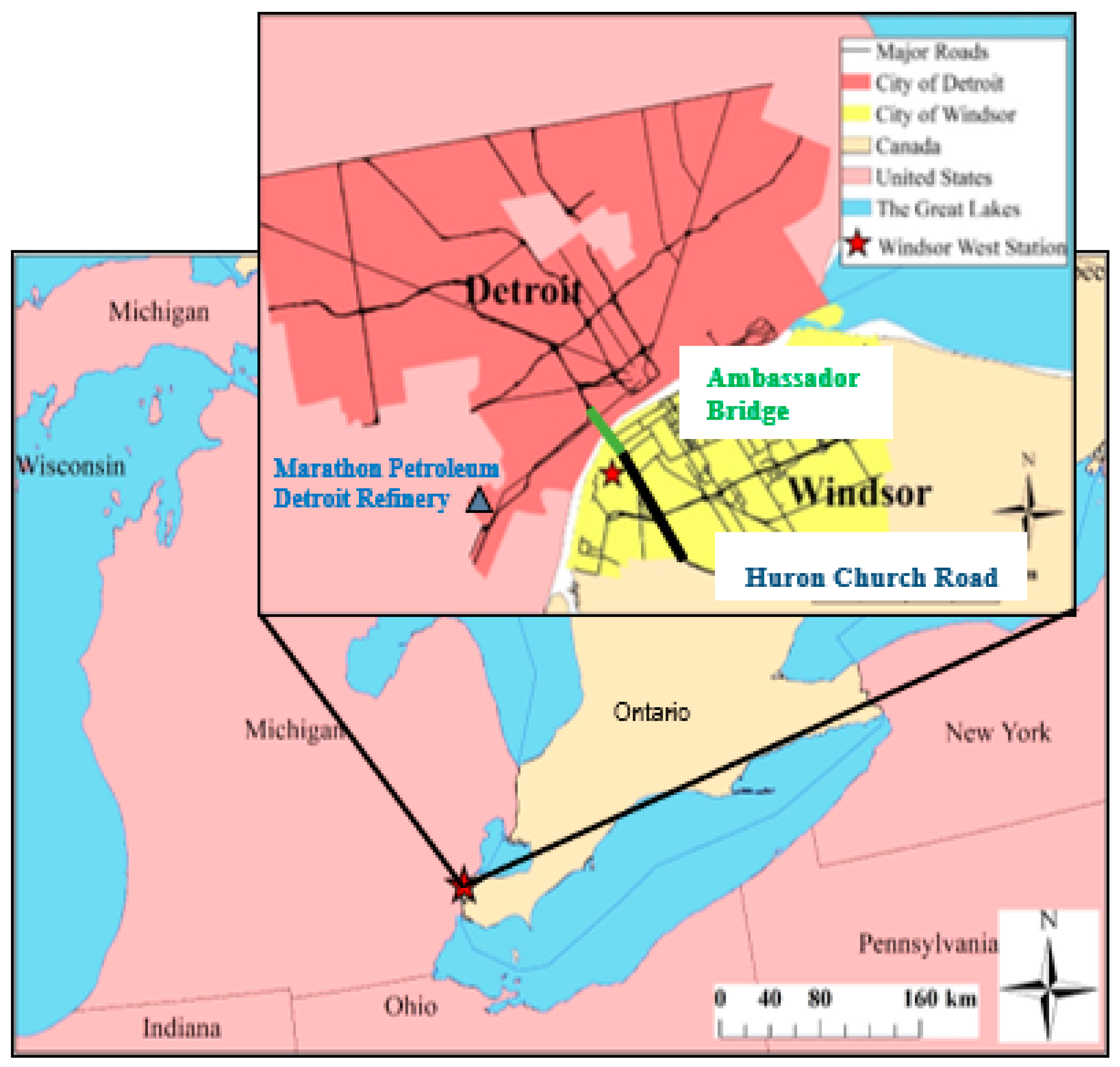
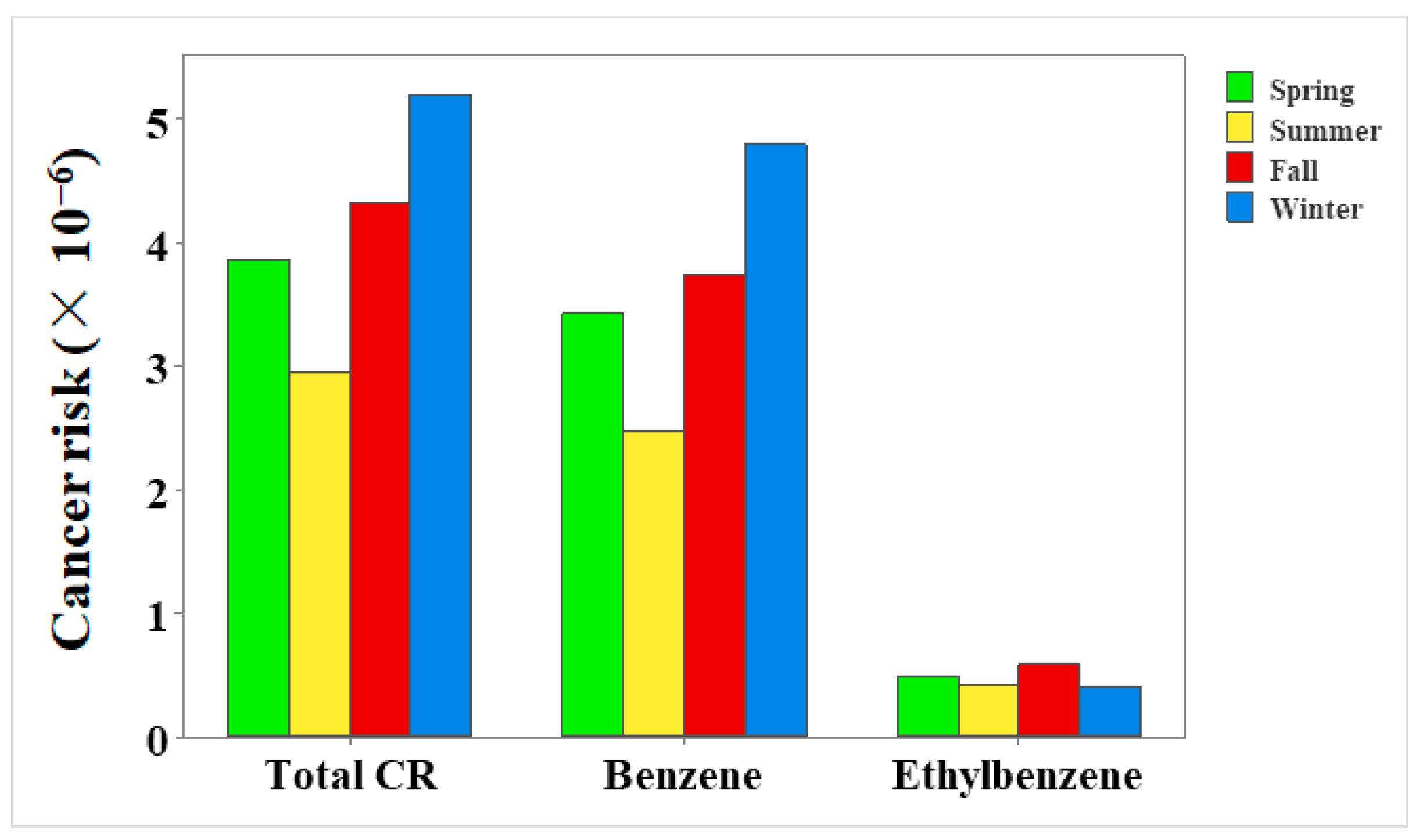
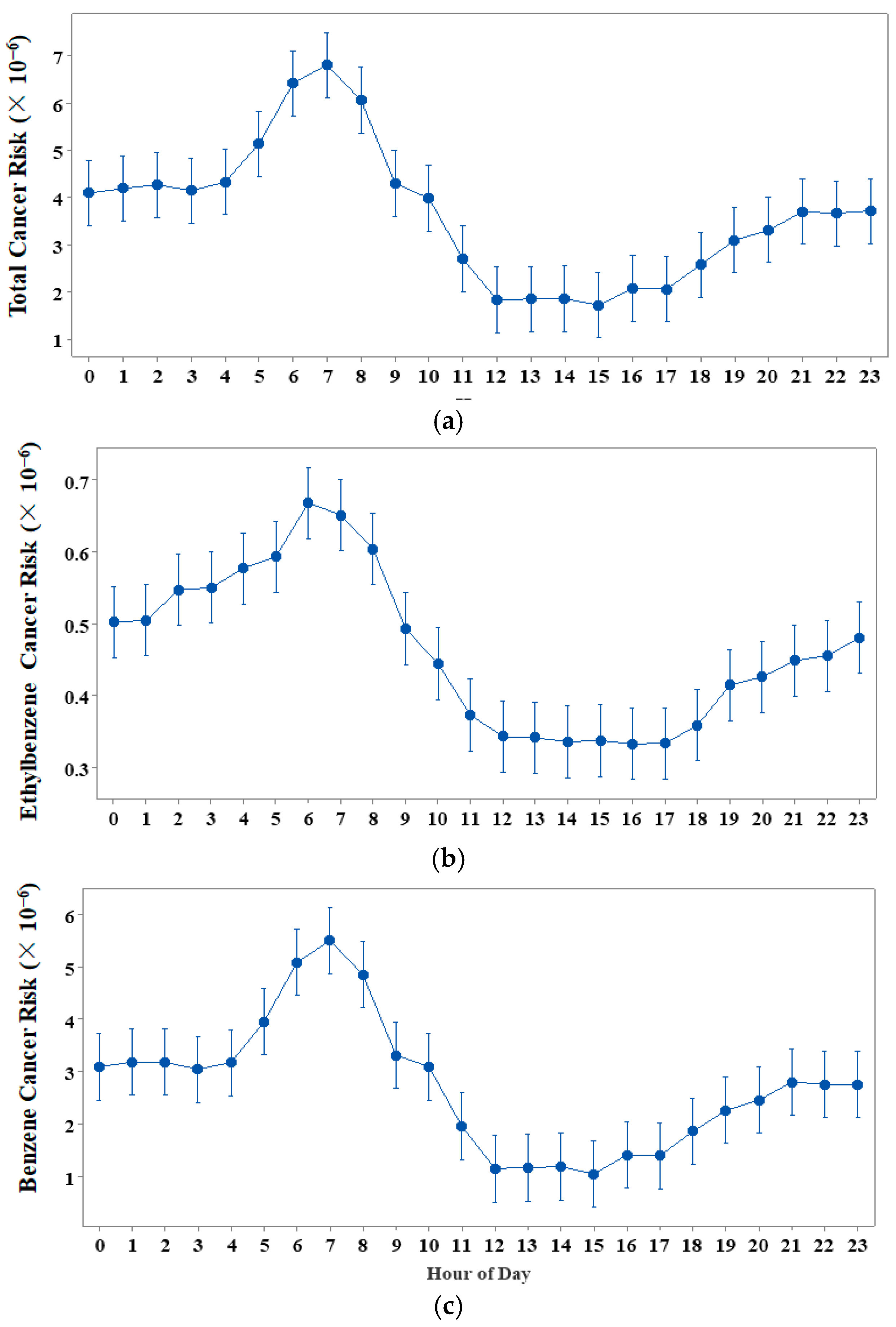
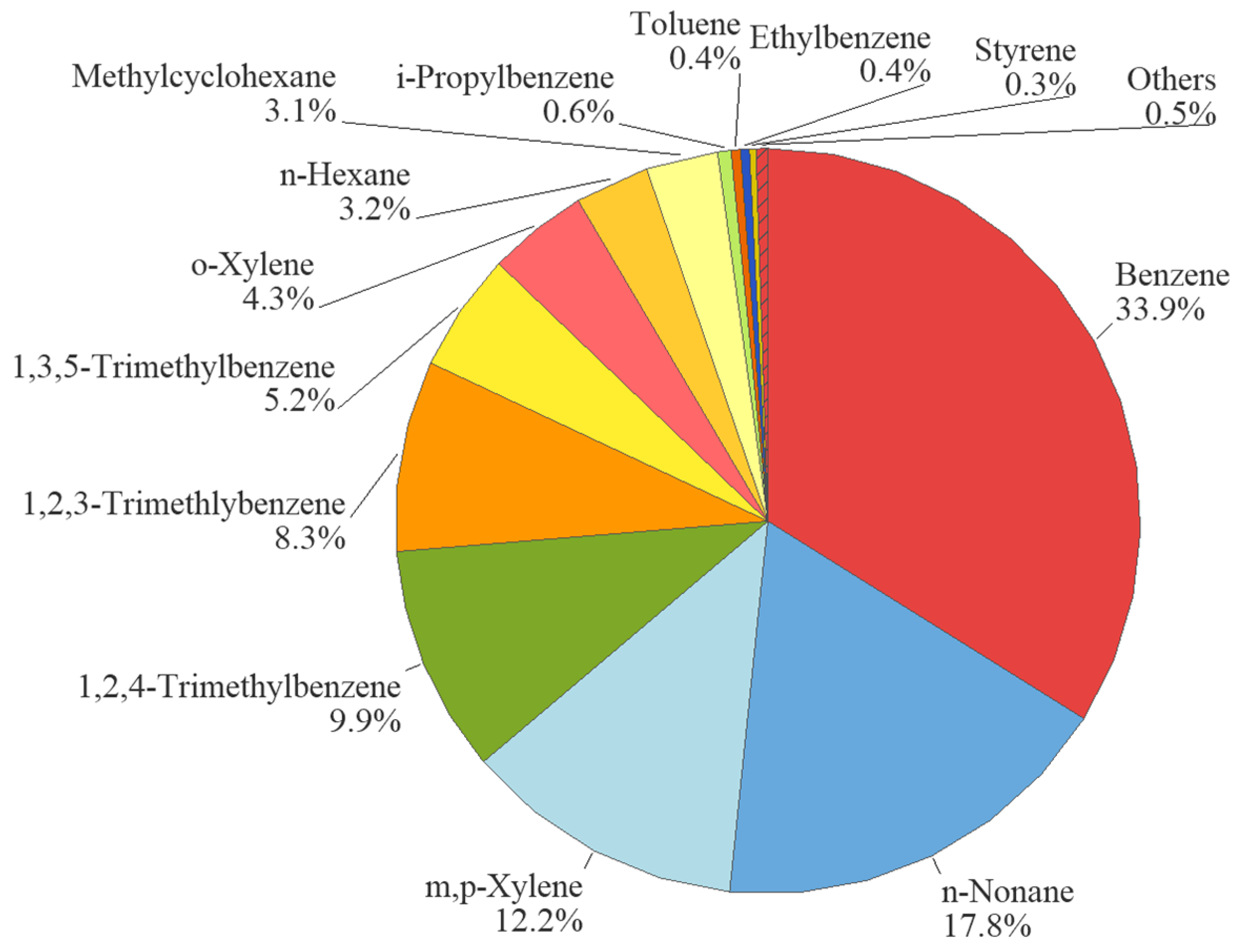
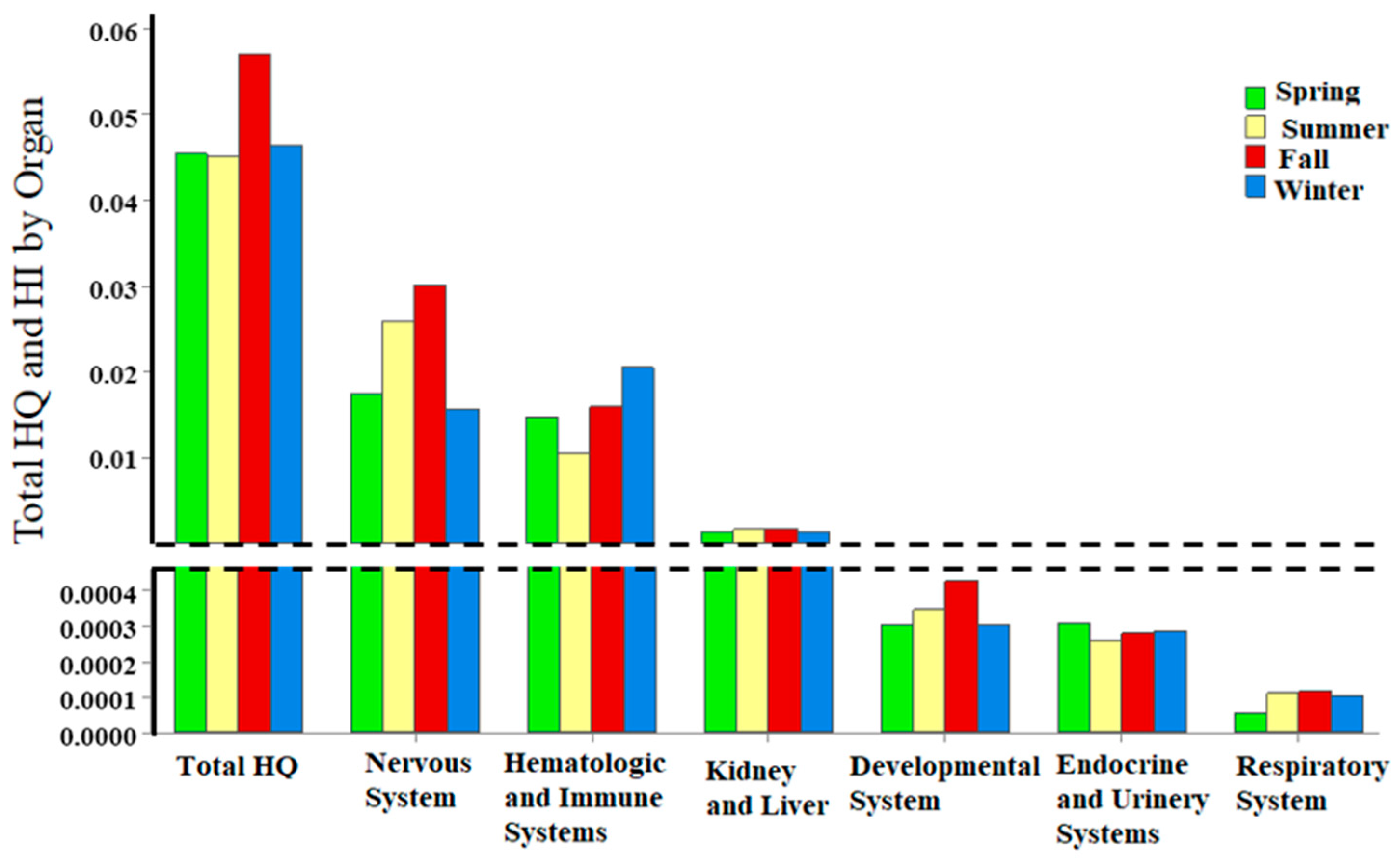
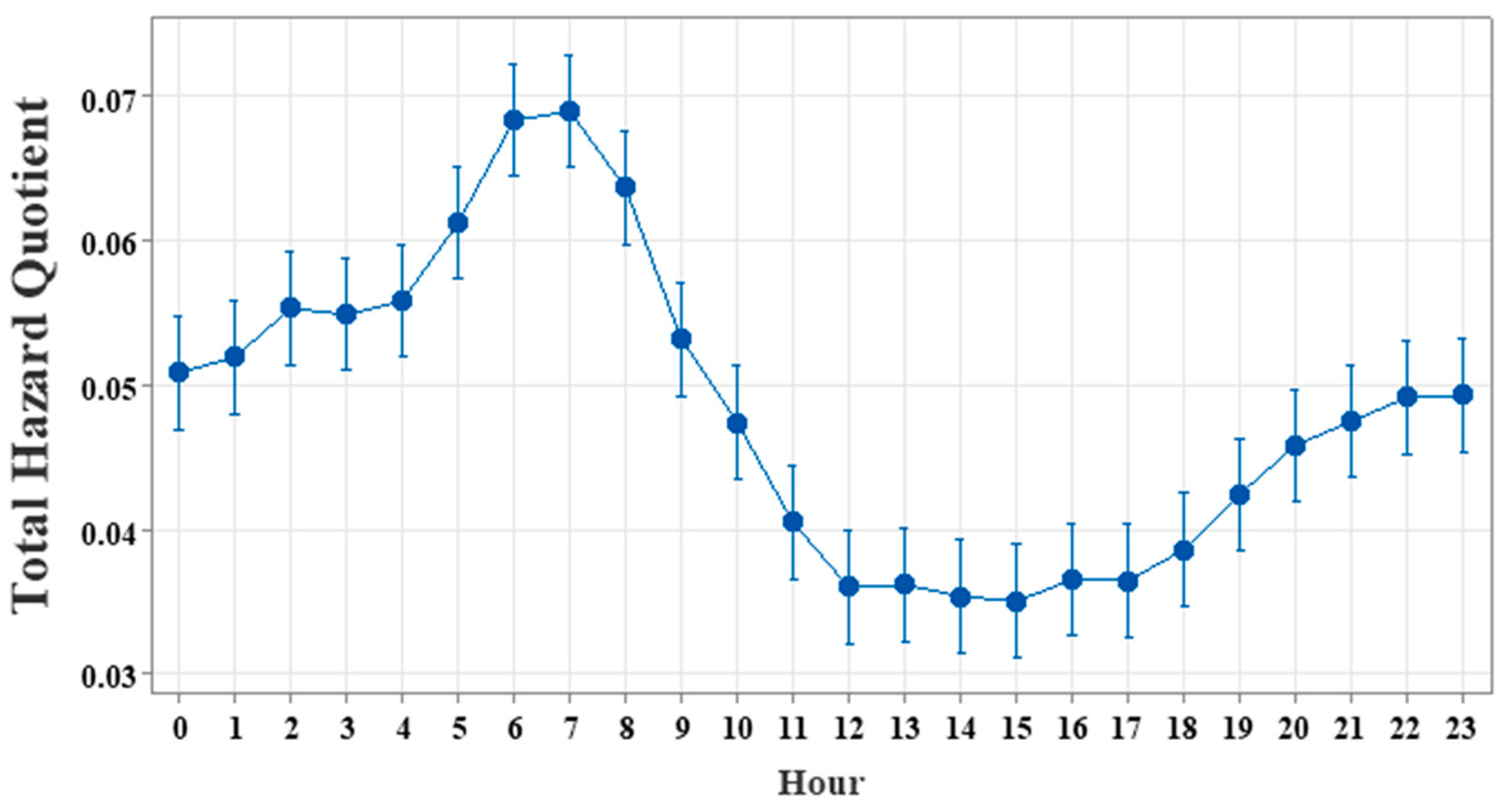
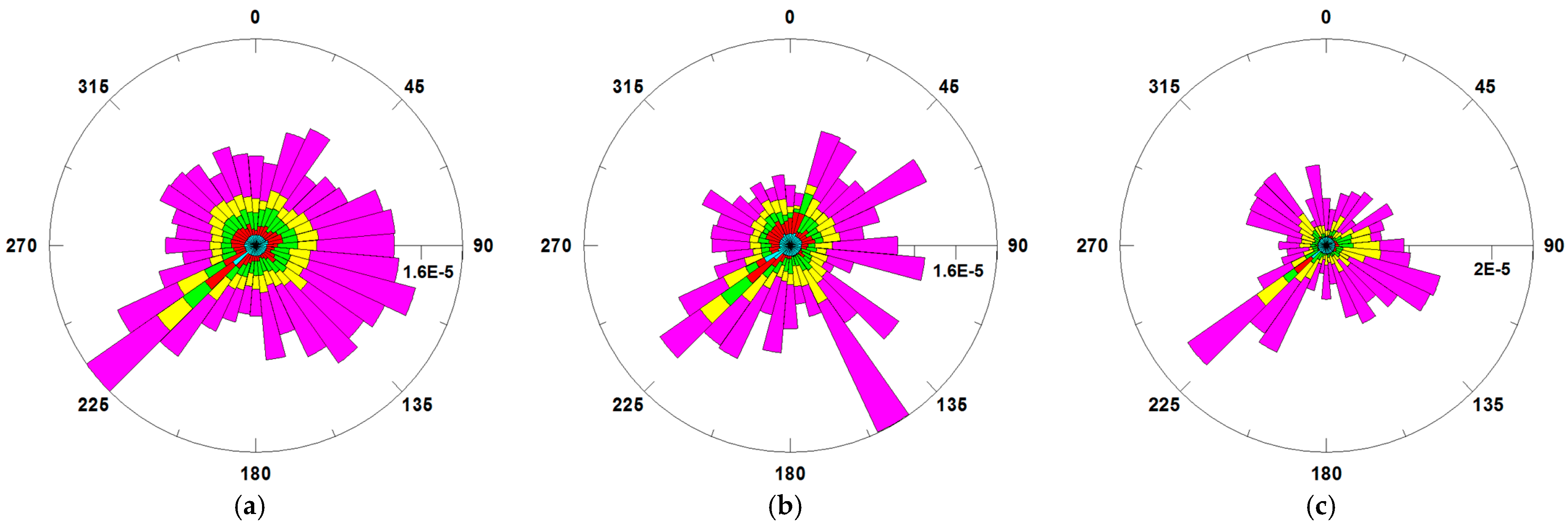
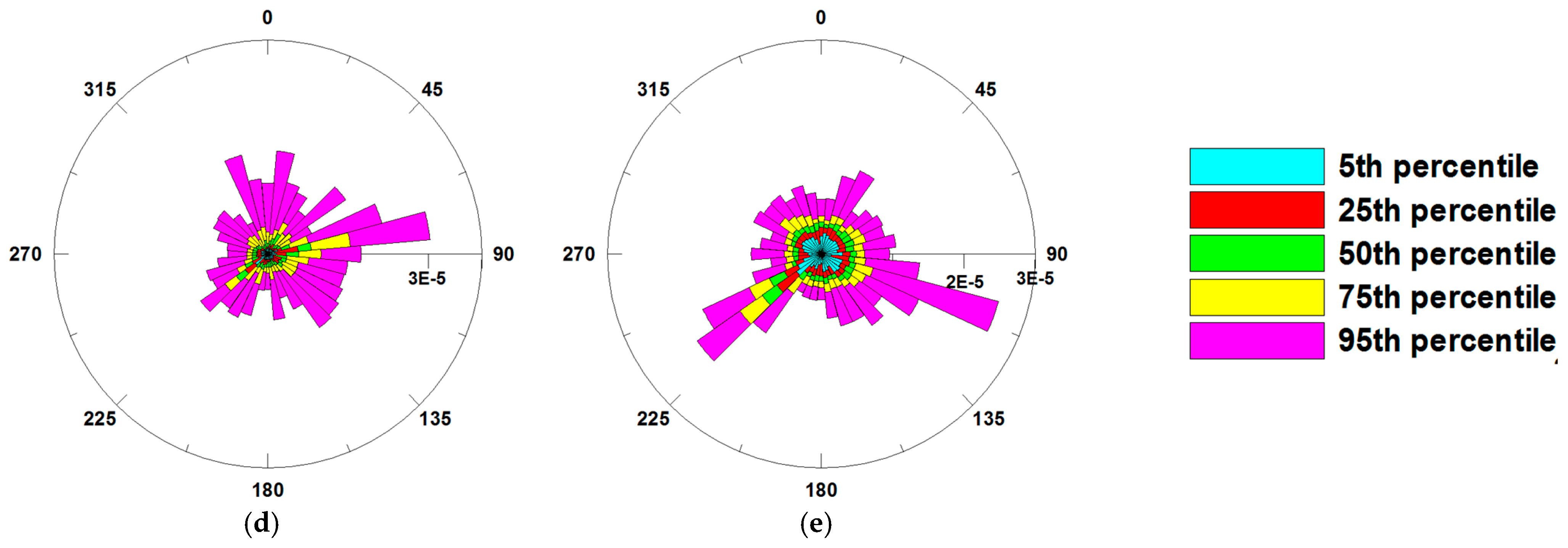
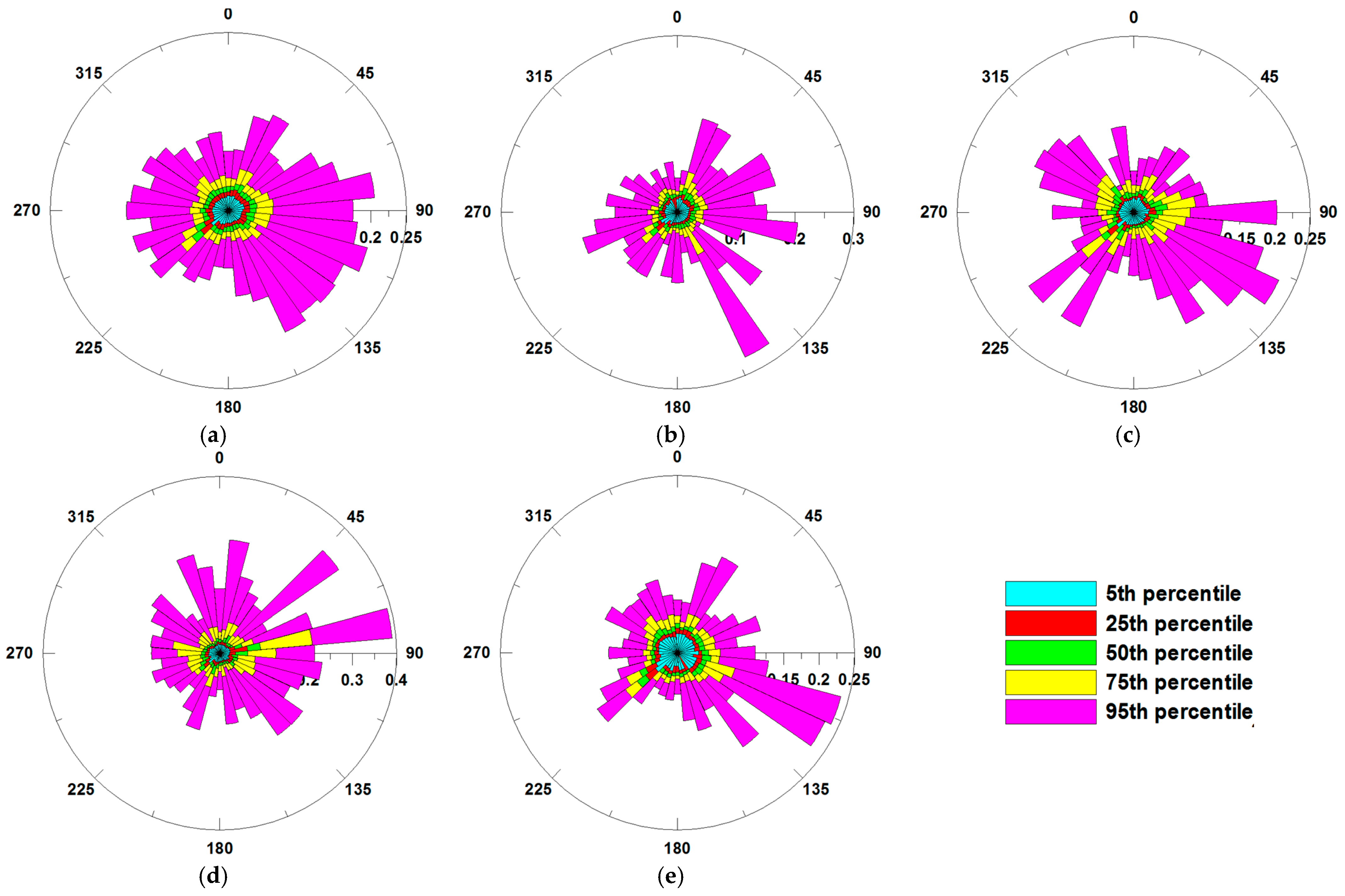
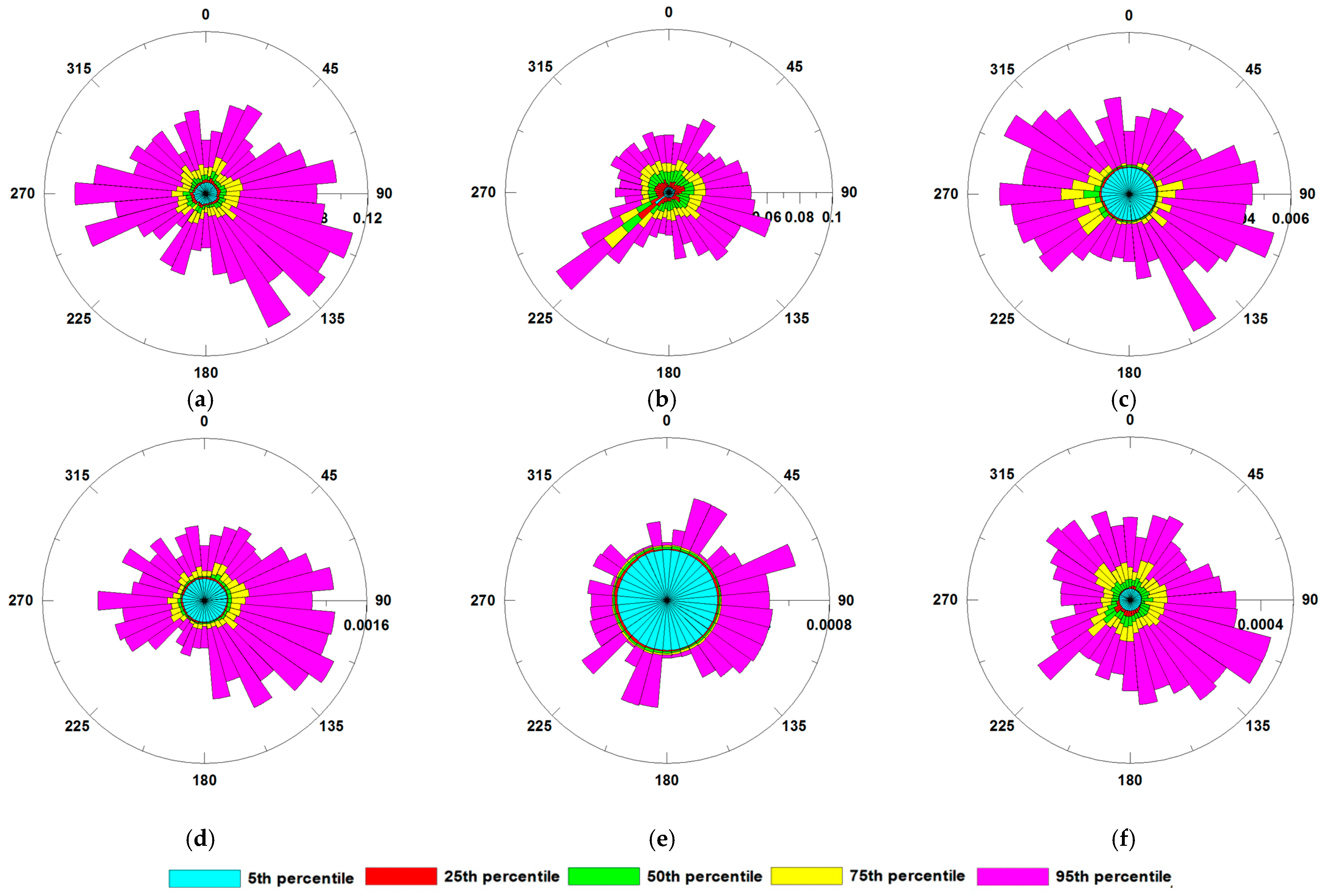
| Compound | Min (µg/m3) | Mean (µg/m3) | Median (µg/m3) | Max (µg/m3) | SD (µg/m3) | CV (%) |
|---|---|---|---|---|---|---|
| n-Nonane | 0.0945 | 0.173 | 0.109 | 3.29 | 0.191 | 110 |
| Benzene | 0.0948 | 0.496 | 0.401 | 5.70 | 0.442 | 89 |
| 1,3,5-Trimethylbenzene | 0.0947 | 0.151 | 0.107 | 2.46 | 0.145 | 96 |
| 1,2,4-Trimethylbenzene | 0.0947 | 0.289 | 0.112 | 6.76 | 0.520 | 180 |
| 1,2,3-Trimethylbenzene | 0.0952 | 0.242 | 0.111 | 3.32 | 0.282 | 116 |
| m,p-Xylene | 0.0947 | 0.595 | 0.342 | 13.2 | 0.822 | 138 |
| o-Xylene | 0.0943 | 0.212 | 0.112 | 5.02 | 0.273 | 129 |
| Methylcyclohexane | 0.0944 | 0.152 | 0.107 | 2.20 | 0.127 | 84 |
| i-Propylbenzene | 0.0947 | 0.113 | 0.105 | 1.04 | 0.0417 | 37 |
| n-Hexane | 0.0950 | 1.10 | 0.301 | 53.1 | 2.90 | 263 |
| Ethylbenzene | 0.0943 | 0.185 | 0.110 | 7.25 | 0.217 | 117 |
| n-Propylbenzene | 0.0947 | 0.132 | 0.105 | 1.04 | 0.0417 | 37 |
| Styrene | 0.0945 | 0.137 | 0.106 | 3.29 | 0.170 | 124 |
| Propene | 0.0964 | 0.291 | 0.199 | 6.57 | 0.315 | 108 |
| Toluene | 0.0970 | 0.999 | 0.629 | 19.0 | 1.26 | 126 |
| Cyclohexane | 0.0950 | 0.122 | 0.105 | 2.52 | 0.0899 | 74 |
| Study Areas | Benzene IUR = 7.8 × 10−6 (µg/m3)−1 [7] | Ethylbenzene IUR = 2.5 × 10−6 (µg/m3)−1 [8] | Total CR | Investigated Compounds | References |
|---|---|---|---|---|---|
| Windsor, ON, Canada | 3.87 × 10−6 | 4.63 × 10−7 | 4.33 × 10−6 | Benzene and ethylbenzene | Present study |
| Port Moody, BC, Canada | 3.8 × 10−5 | 2.8 × 10−6 | 1.4 × 10−4 | 11 VOCs | [20] |
| Burnaby, BC, Canada | 2.8 × 10−5 | 1.4 × 10−6 | 1.1 × 10−4 | 11 VOCs | [20] |
| Athabasca oil sands region, AB, Canada | 6.51 × 10−6 | 1.55 × 10−6 | 2.69 × 10−5 | Benzene, ethylbenzene, and acetaldehyde | [18] |
| Harbin, China | 4.73 × 10−6 | 6.39 ×10−7 | 5.37 × 10−6 | Benzene and ethylbenzene | [13] |
| Beijing, China | 4.96 ×10−6 | 4.96 × 10−6 | Benzene only | [26] | |
| Zhengzhou, China | 1.0 × 10−6 | 2.45 ×10−7 | 2.92 × 10−5 | 21 VOCs | [27] |
| Compound | RfC (µg/m3) | Target Organs | Mean Concentration (µg/m3) [Rank] | HQ | Contribution to HI (%) [Rank] |
|---|---|---|---|---|---|
| n-Nonane | 20 | N.A. | 0.173 [10] | 0.00866 | 17.7 [2] |
| Benzene | 30 | Hematologic and immune system | 0.496 [4] | 0.0165 | 33.9 [1] |
| 1,3,5-Trimethylbenzene | 60 | Nervous system | 0.151 [12] | 0.00252 | 5.17 [6] |
| 1,2,4-Trimethylbenzene | 60 | Nervous system | 0.289 [6] | 0.00482 | 9.88 [4] |
| 1,2,3-Trimethylbenzene | 60 | Nervous system | 0.242 [7] | 0.00403 | 8.28 [5] |
| m,p-Xylene | 100 | Nervous system | 0.595 [3] | 0.00595 | 12.2 [3] |
| o-Xylene | 100 | Nervous system | 0.212 [8] | 0.00212 | 4.35 [7] |
| Methylcyclohexane | 100 | Liver/ kidney | 0.152 [11] | 0.00152 | 3.12 [9] |
| i-Propylbenzene | 400 | Endocrine and urinary system | 0.113 [16] | 0.000282 | 0.578 [10] |
| n-Hexane | 700 | Nervous system | 1.10 [1] | 0.00157 | 3.23 [8] |
| Ethylbenzene | 1000 | Developmental system | 0.185 [9] | 0.000185 | 0.379 [12] |
| n-Propylbenzene | 1000 | Developmental system | 0.132 [14] | 0.000132 | 0.270 [14] |
| Styrene | 1000 | Nervous system | 0.137 [13] | 0.000137 | 0.281 [13] |
| Propene | 3000 | Respiratory system | 0.291 [5] | 0.000097 | 0.199 [15] |
| Toluene | 5000 | Nervous system | 0.999 [2] | 0.0002 | 0.409 [11] |
| Cyclohexane | 6000 | Developmental system | 0.122 [15] | 0.0000203 | 0.0416 [16] |
| Total HQ | 0.0488 | 100 |
| Compound | Windsor, ON, Canada | Port Moody, BC, Canada | Burnaby, BC, Canada | Düzce, Turkey | Harbin, China | Zhengzhou, China | Beijing, China |
|---|---|---|---|---|---|---|---|
| n-Nonane | 8.66 × 10−3 | 2.00 × 10−2 | |||||
| Benzene | 1.65 × 10−2 | 2.02 × 10−1 | 1.51 × 10−1 | 9.00 × 10−2 | 5.06 × 10−2 | 4.27 × 10−3 | 4.91 × 10−5 |
| 1,3,5-Trimethylbenzene | 2.52 × 10−3 | 7.00 × 10−3 | |||||
| 1,2,4-Trimethylbenzene | 4.82 × 10−3 | 7.00 × 10−3 | |||||
| 1,2,3-Trimethylbenzene | 4.03 × 10−3 | 4.00 × 10−3 | |||||
| m,p-Xylene | 5.95 × 10−2 | 1.00 × 10−2 | 2.20 × 10−3 | 1.32 × 10−3 | 1.92 × 10−4 | ||
| o-Xylene | 2.12 × 10−3 | 7.00 × 10−3 | 1.09 × 10−3 | 1.08 × 10−3 | 8.55 × 10−3 | ||
| Methylcyclohexane | 1.52 × 10−3 | 5.00 × 10−5 | |||||
| i-Propylbenzene | 2.82 × 10−4 | ||||||
| n-Hexane | 1.57 × 10−3 | 7.33 × 10−5 | 4.38 × 10−5 | 6.00 × 10−4 | |||
| Ethylbenzene | 1.85 × 10−4 | 2.62 × 10−4 | 1.32 × 10−4 | 7.00 × 10−4 | 1.16 × 10−4 | 9.81 × 10−5 | 4.13 × 10−4 |
| n-Propylbenzene | 1.32 × 10−4 | ||||||
| Styrene | 1.37 × 10−4 | 2.11 × 10−4 | 1.06 × 10−4 | 4.00 × 10−4 | |||
| Propene | 9.70 × 10−5 | 1.60 × 10−4 | 1.10 × 10−4 | ||||
| Toluene | 2.00 × 10−4 | 9.17 × 10−3 | 6.29 × 10−3 | 9.00 × 10−4 | 1.73 × 10−4 | 6.46 × 10−5 | 1.88 × 10−4 |
| Cyclohexane | 2.03 × 10−5 | 3.00 × 10−5 | |||||
| References | Present Study | [20] | [20] | [12] | [13] | [27] | [26] |
| Compound | Nervous System (% of HI) | Hematologic System and Immune System | Liver/Kidney | Developmental System (% of HI) | Endocrine System and Urinary System | Respiratory System |
|---|---|---|---|---|---|---|
| Benzene | 1.65 × 10−2 | |||||
| 1,3,5-Trimethylbenzene | 2.52 × 10−3 (12%) | |||||
| 1,2,4-Trimethylbenzene | 4.82 × 10−3 (23%) | |||||
| 1,2,3-Trimethylbenzene | 4.03 × 10−3 (19%) | |||||
| m,p-Xylene | 5.95 × 10−2 (28%) | |||||
| o-Xylene | 2.12 × 10−3 (10%) | |||||
| Methylcyclohexane | 1.52 × 10−3 | |||||
| i-Propylbenzene | 2.80 × 10−4 | |||||
| n-Hexane | 1.57 × 10−3 (7%) | |||||
| Ethylbenzene | 1.85 × 10−4 (55%) | |||||
| n-Propylbenzene | 1.32 × 10−4 (39%) | |||||
| Styrene | 1.37 × 10−4 (1%) | |||||
| Propene | 9.70 × 10−5 | |||||
| Toluene | 2.00 × 10−4 (1%) | |||||
| Cyclohexane | 2.03 × 10−5 (6%) | |||||
| Hazard Index (HI) | 2.13 × 10−2 | 1.65 × 10−2 | 1.52 × 10−3 | 3.37 × 10−4 | 2.80 × 10−4 | 9.70 × 10−5 |
Disclaimer/Publisher’s Note: The statements, opinions and data contained in all publications are solely those of the individual author(s) and contributor(s) and not of MDPI and/or the editor(s). MDPI and/or the editor(s) disclaim responsibility for any injury to people or property resulting from any ideas, methods, instructions or products referred to in the content. |
© 2024 by the authors. Licensee MDPI, Basel, Switzerland. This article is an open access article distributed under the terms and conditions of the Creative Commons Attribution (CC BY) license (https://creativecommons.org/licenses/by/4.0/).
Share and Cite
Mihankhah, T.; Su, Y.; Zhang, T.; Wang, J.; Gilmore, J.; Noble, M.; Munoz, A.; Charron, C.; Xu, X. Health Risk Assessment of Ambient Volatile Organic Compounds in a Border City in Canada. Atmosphere 2024, 15, 1038. https://doi.org/10.3390/atmos15091038
Mihankhah T, Su Y, Zhang T, Wang J, Gilmore J, Noble M, Munoz A, Charron C, Xu X. Health Risk Assessment of Ambient Volatile Organic Compounds in a Border City in Canada. Atmosphere. 2024; 15(9):1038. https://doi.org/10.3390/atmos15091038
Chicago/Turabian StyleMihankhah, Taraneh, Yushan Su, Tianchu Zhang, Jonathan Wang, James Gilmore, Michael Noble, Anthony Munoz, Chris Charron, and Xiaohong Xu. 2024. "Health Risk Assessment of Ambient Volatile Organic Compounds in a Border City in Canada" Atmosphere 15, no. 9: 1038. https://doi.org/10.3390/atmos15091038
APA StyleMihankhah, T., Su, Y., Zhang, T., Wang, J., Gilmore, J., Noble, M., Munoz, A., Charron, C., & Xu, X. (2024). Health Risk Assessment of Ambient Volatile Organic Compounds in a Border City in Canada. Atmosphere, 15(9), 1038. https://doi.org/10.3390/atmos15091038









